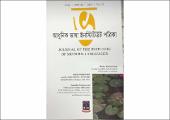JavaScript is disabled for your browser. Some features of this site may not work without it.
Mostrar el registro sencillo del ítem
Bengali and Spanish vowels: a comparative analysis
| dc.rights.license | Licencia Creative Commons Atribución – No Comercial – Sin Derivadas (CC BY-NC-ND 4.0) | es |
| dc.contributor.author | Chowdhury, Abdullah Rafique-um-Munir | |
| dc.contributor.author | Hossain, Md Imran | |
| dc.date.accessioned | 2023-12-19T19:42:51Z | |
| dc.date.available | 2023-12-19T19:42:51Z | |
| dc.date.issued | 2020 | |
| dc.identifier.uri | https://hdl.handle.net/10895/4563 | |
| dc.description.abstract | Bengali and Spanish differ in their vowel systems. Bengalí has seven vowels /i, e, ɛ, a, ɔ, o, u/ and Spanish has five vowels: /i, e, a, o, u/. This study compared the acoustic characteristics of Bengali and Spanish oral vowels. F1 and F2 data were collected from speech samples using Praat software. Results showed that Spanish vowels' space was smaller than Bengali. Some realizations of Spanish /i/, /o/ and /a/ were similar to Bengali /e/, /u/ and /ɛ/ respectively. Moreover, open allophones of Spanish /e/ and /o/ —[ɛ] and [ɔ] respectively— have potential to be perceived as Bengali /ɛ/ and /ɔ/ phonemes. In conclusion, this comparison of the vowel systems suggest that Bengali speakers would tend to convert the penta-vocalic system of Spanish into a hepta-vocalic system due to similarities in acoustic realizations; they may use open [ɛ] and [ɔ] as frequent allophones of Spanish /a/ and /o/ respectively. | es |
| dc.format.mimetype | application/pdf | |
| dc.language.iso | bn | es |
| dc.publisher | Dhaka University | es |
| dc.relation.ispartof | Journal of the Institute of Modern Languages, 31, 141-153 | es |
| dc.subject | Bengali vowels | es |
| dc.subject | Spanish vowels | es |
| dc.subject | Phonetics | es |
| dc.title | Bengali and Spanish vowels: a comparative analysis | es |
| dc.type | Artículo | es |
Ficheros en el ítem
Este ítem aparece en la(s) siguiente(s) colección(ones)
-
Artículos [51]


